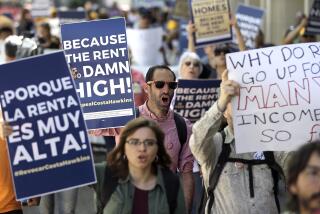Saving homes with a ‘right to rent’
- Share via
Less than 10% of homeowners facing foreclosure have benefited from the Obama administration’s mortgage modification program, according to a Treasury Department report this month. This plan is the third federal mortgage modification plan in the last two years, but the foreclosure rate continues to skyrocket, with the country now on a path to 2 million foreclosures this year.
It’s time to try a new route for helping homeowners. There is a simple alternative: Congress can pass legislation that gives homeowners facing foreclosure the right to stay in their home as renters. This “right to rent” policy would require no taxpayer money, no new bureaucracy and could immediately benefit homeowners facing foreclosure.
The basic idea is simple. In recognition of the extraordinary crisis, Congress would give families that took out mortgages at the peak of the boom and are facing foreclosure the option to remain in their homes as renters for a substantial period of time -- five to 10 years -- while paying the market-rate rent. Earlier this year, Freddie Mac launched a similar policy, giving former homeowners the option to lease their recently foreclosed properties, but on a month-to-month basis. That was a positive step, but it does not give families the housing security they need.
In the markets affected most by the housing bubble bursting, the current rents would be 30% to 50% less than the monthly mortgage payments for homes purchased near the peak of the bubble. This means that many families that cannot afford their mortgage payments would likely be able to afford the market rent.
Although they would lose ownership of their homes under “right to rent,” the residents would be able to stay in their homes, neighborhoods and schools. This would provide families facing foreclosure with needed stability and housing security.
Further, “right to rent” would enable more families to stay in their homes as owners, by giving banks an extra incentive to pursue mortgage modifications. Currently, in spite of the various government programs, most banks have little incentive to pursue modifications. In fact, the Treasury Department reported that as of July, Home Loan Services Inc., with more than 30,000 delinquent loans, was among those that had yet to initiate a single modification under the government’s “Making Home Affordable Program.” While a bank would still be able to sell a home after a foreclosure, the “right to rent” would attach to the home, so that a new owner would have to honor it. This could deter the sale of a home, because a home is much less marketable if it comes with a long-term tenant. If lenders know that they could get stuck with a tenant for five to 10 years, foreclosure would be a much less attractive option.
By keeping homes occupied, “right to rent” also would be a boon to communities that have been especially hard-hit by foreclosures. Often foreclosed homes are abandoned, with unkempt lawns, broken windows and other property damage. Such homes can attract squatters or become havens for drug use and other crimes, which endangers the neighborhood and brings down property values.
“Right to rent” even could slow the general decline in home prices by reducing the volume of homes that are foreclosed and resold on the market. The current rate of almost 2 million annual foreclosures is equal to almost 40% of demand for new and existing homes. If this plan helps reduce the supply of foreclosed homes coming on the market, it would help to stem the slide in home prices.
There is no doubt that the banks would hate “right to rent” legislation. They will likely use all their political power to defeat any bill -- and banks are incredibly powerful on Capitol Hill. But we should remember that it was the banks’ greed and incompetence that got us into this mess in the first place.
“Right to rent” is a simple but important break for homeowners who are bearing the brunt of the collapse of the housing bubble. It’s time the banks offered these families a little help.
More to Read
Inside the business of entertainment
The Wide Shot brings you news, analysis and insights on everything from streaming wars to production — and what it all means for the future.
You may occasionally receive promotional content from the Los Angeles Times.










